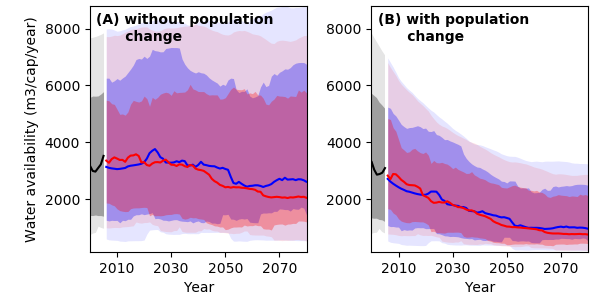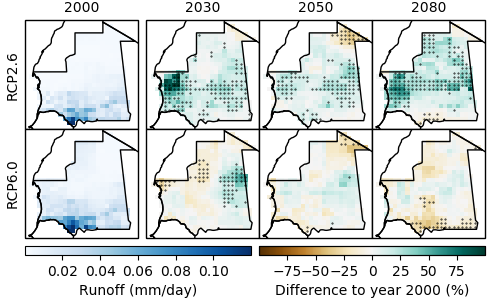Mauritania: Water resources
Mauritania has experienced strong seasonal and annual variation in precipitation as well as recurring droughts, all of which present major constraints to agricultural production [16], [17]. The country was hit by recurring droughts in the 1970s and 1980s as precipitation amounts decreased during that time [18]. This decrease in precipitation led to critical reductions in water resources and vegetation, increased land degradation and desertification, which resulted in loss of arable land and reduced agricultural production, as well as loss of pastures and livestock depletion [18]. Poverty rates soared in already vulnerable rural communities and created a mass exodus to urban centres [18]. While in 1980, only 27 % of Mauritania’s population was urban, this figure increased more than twofold to 55 % in 2019 [2]. Furthermore, the effects of drought sparked conflicts between farmers and herders in the Senegal River Valley, leading to the Senegal-Mauritania Conflict in 1989 with thousands of people killed and hundreds of thousands displaced [19], [20]. Although annual precipitation sums recovered in the 1990s, they remain below the national average of the past century with further droughts recorded in 2005, 2008, 2010 and 2012 [17], [21]. Overall, Mauritania’s freshwater resources are very unevenly distributed with concentrations along the southern border, leaving the country’s growing population under water stress and in competition over limited water resources.
Per capita water availability

Current projections of water availability in Mauritania display high uncertainty under both GHG emissions scenarios. Assuming a constant population level, multi-model median projections suggest only little change in per capita water availability over Mauritania by the end of the century under either RCP (Figure 9A). Yet, when accounting for population growth according to SSP2 projections5, per capita water availability for Mauritania is projected to decline by 71 % under RCP2.6 and 77 % under RCP6.0 by 2080 relative to the year 2000 (Figure 9B). While this decline is primarily driven by population growth rather than climate change, it highlights the urgency to invest in water saving measures and technologies for future water consumption after 2030.
Spatial distribution of water availability

Projections of future water availability from precipitation vary depending on the region and scenario (Figure 10). In line with precipitation projections, water availability is projected to increase in parts of western, central and north-eastern Mauritania under RCP2.6. Under RCP6.0, however, model agreement is low with precipitation decreases of up to 30 % projected for the south of Mauritania. The projected increase in water availability under RCP2.6 is based on a constant population level. Hence, water saving measures are likely to become important for Mauritania’s rapidly growing population.
5 Shared Socio-economic Pathways (SSPs) outline a narrative of potential global futures, including estimates of broad characteristics such as country level population, GDP or rate of urbanisation. Five different SSPs outline future realities according to a combination of high and low future socio-economic challenges for mitigation and adaptation. SSP2 represents the “middle of the road”-pathway.
References
[17] P. Ozer, Y. C. Hountondji, J. Gassani, B. Djaby, and D. L. F, “Évolution récente des extrêmes pluviométriques en Mauritanie (1933–2010),” XXVIIeme Colloq. l’Association Int. Climatol., pp. 394–400, 2014.
[18] Islamic Republic of Mauritania, “National Adaptation Programme of Action to Climate Change,” Nouakchott, Mauritania, 2004.
[19] R. Parker, “The Senegal–Mauritania Conflict of 1989: a Fragile Equilibrium,” J. Mod. Afr. Stud., vol. 29, no. 1, pp. 155–171, Mar. 1991.
[20] A. Nicolaj, “The Senegal Mauritanian Conflict,” Africa Riv. Trimest. di Stud. e Doc. dell’Instituto Ital. per l’Africa e l’Oriente, vol. 45, no. 3, pp. 464–480, 1990.
[21] USAID, “Climate Change Risk Profile: West African Sahel,” Washington, D.C., 2017.


